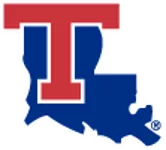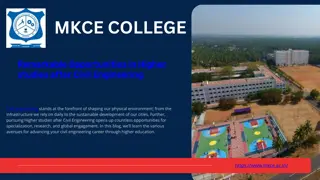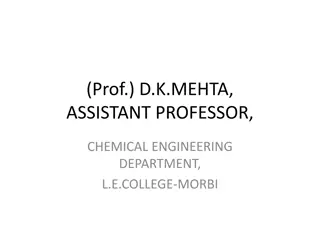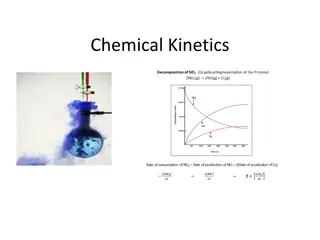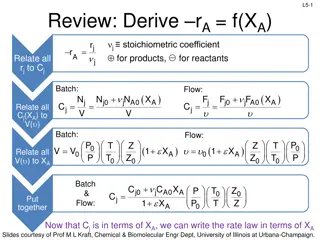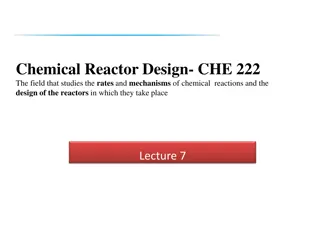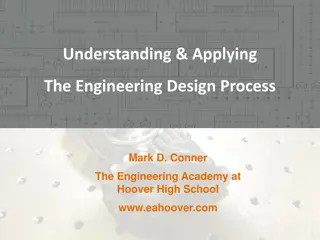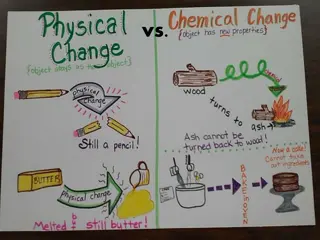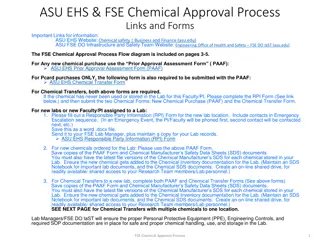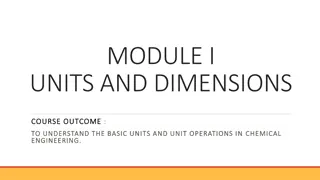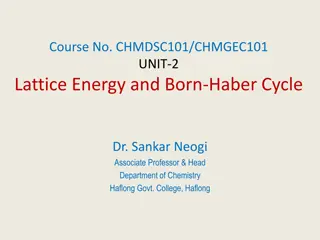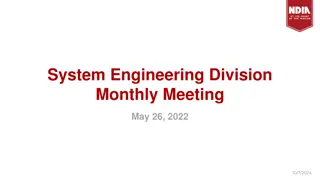Overview of Chemical Engineering Process Design
Chemical engineering process design involves problem definition, process synthesis, design, and analysis to efficiently eliminate solutions, produce financial estimates, understand risks, and create necessary documentation. It includes investigation of feeds, products, reactor design, and separation processes for optimal performance while considering societal and environmental impacts.
Download Presentation

Please find below an Image/Link to download the presentation.
The content on the website is provided AS IS for your information and personal use only. It may not be sold, licensed, or shared on other websites without obtaining consent from the author. Download presentation by click this link. If you encounter any issues during the download, it is possible that the publisher has removed the file from their server.
E N D
Presentation Transcript
Outline of Chemical Engineering Process Design Feed Product Process Goal 1. Eliminate solutions efficiently. Goal 2. Produce a financial estimate Goal 3. Understand the risk that the process poses to society and the environment Goal 4. Produce the documentation required to build the process. Mody, D., & Strong, D. (2011). An Overview of Chemical Process Design Engineering. Proceedings of the Canadian Engineering Education Association. https://doi.org/10.24908/pceea.v0i0.3824
Outline of Chemical Engineering Process Design Feed Product Process 1. Problem Definition 2. Process Synthesis (Multiple solutions are generated and discarded as quickly as possible to produce a small number of favorable solutions that are taken to more detail) 3. Process Design (One or two most favored solutions are developed in enough detail that reasonable financial analysis can be performed, safety and environmental issues can be identified and their risk understood.) 4. Process Analysis (In this stage optimization of the conditions or equipment will be performed.) Mody, D., & Strong, D. (2011). An Overview of Chemical Process Design Engineering. Proceedings of the Canadian Engineering Education Association. https://doi.org/10.24908/pceea.v0i0.3824
Outline of Chemical Engineering Process Design Feed Product Process 1. Investigate possible feeds and products. (Problem Definition) Feeds: A. B. C. Product: A. B. C. Each with different compositions, costs, and availability Each with different compositions, costs, and availability
Outline of Chemical Engineering Process Design Product Feed Feed Stream Preparation Reaction Separation Waste Utilities Heat Exchanger Network Separation/ Recycle Reactor
Reactor 1. Pick and appropriate model. a. Kinetics b. Thermodynamics c. Encompass appropriate reactants and products 2. Initial design a) Reactor type(s) / overall reaction scheme b) Materials c) Approximate scale of reactor d) Basic understanding of economics of reaction. 3. Initial Optimization a) Focused on learning the reaction and becoming familiar with how T, P, input composition, catalysts, residence time, etc. affect the reaction. b) If using a multi-reactor set-up, then learning how the reactors affect one another is important here. Not looking for a final answer yet, You are looking for a understanding of the unit: what parameters affect the output, and how to control the process. Could have multiple good solutions
Separation Reaction Separation 1. Pick an appropriate model. a) Thermodynamic model 1. Pick an appropriate model. a. Kinetics b. Thermodynamics c. Encompass appropriate reactants and products Initial design a) Reactor type(s) / overall reaction scheme b) Materials c) Approximate scale of reactor d) Basic understanding of economics. Initial Optimization a) Focused on learning the reaction and becoming familiar with how T, P, input composition, catalysts, etc. affect the reaction. b) If using a multi-reactor set-up, then learning how the reactors affect one another is important here. 2. Initial design a) Separation type(s) / overall separation scheme b) Materials c) Approximate scale of separation d) Basic understanding of economics Initial Optimization a) Focused on learning the separation and becoming familiar with how T, P, input composition, etc. affect the separation. b) If using a multi-step set-up, then learning how the units affect one another is important here. 2. 3. 3. Not looking for a final answer yet, You are looking for a understanding of the unit: what parameters affect the output, and how to control the process. Could have multiple good solutions
Recycle / other topological consideration / Heat Exchanger Integration 1. If any other major units are required (, then perform the same design of those units. 2. Use what you learned in the design of each units to create candidate topologies for optimal process (generally includes a recycle). 3. Optimize the overall process. a) The process at this point is very interconnected and has a large number of process variable (T, P of each unit, residence time, number of trays, specified compositions, etc.), this is a large, likely difficult multivariable optimization. b) A good understanding at previous steps will go a long way to optimizing the overall process. c) This is ultimately an economic optimization, so a you need a good economic model. Now you re starting to converge on a final answer
Final Steps Other design considerations: 1. Safety: safety factors, interlocks, etc. 2. Start-up/shutdown. 3. Steady state control of process 4. Flexible design a) How are changes in feed handled? b) If a different feed is more abundant later, or a different product is more desirable later, can the specified process handle those changes? c) Can units be designed such that they could handle such changes with only minor increases in capital costs? Remember: 1. Optimization and justification are required for each step 2. Keep in mind the ultimate objection, not just the immediate one






